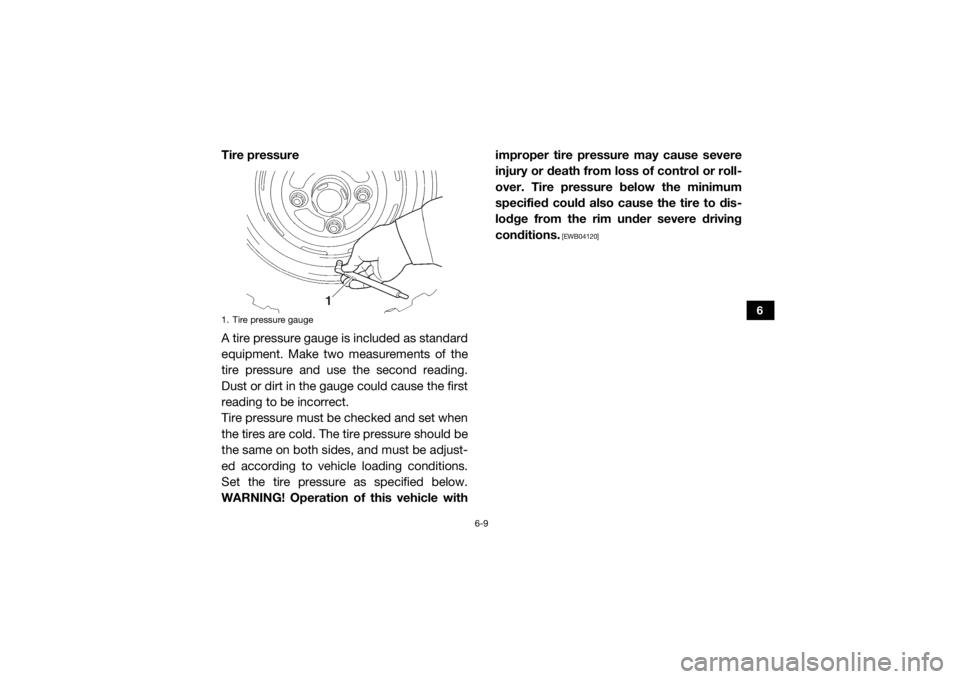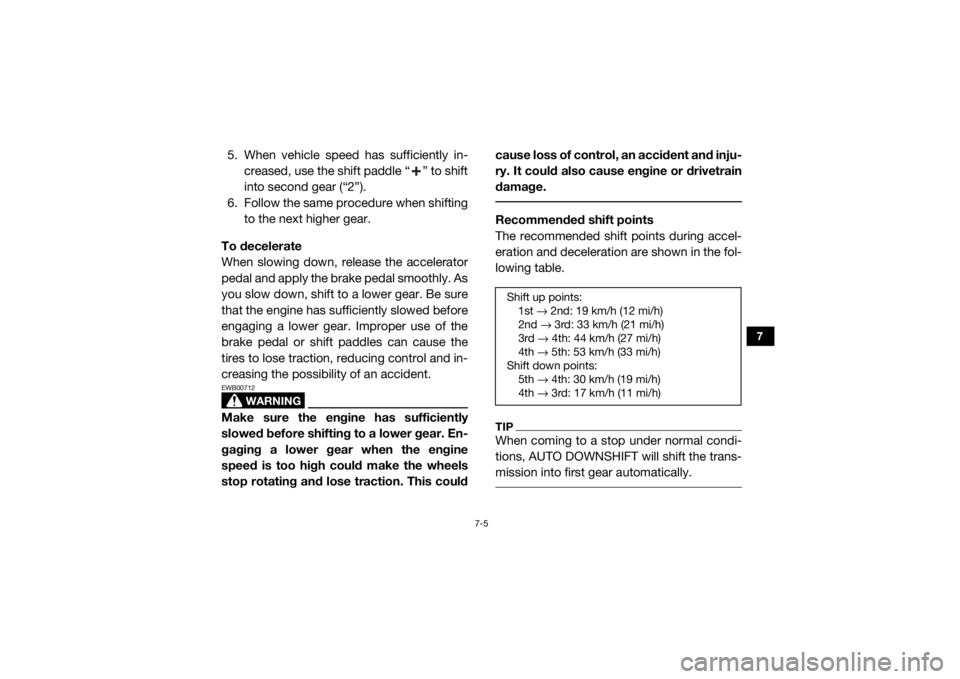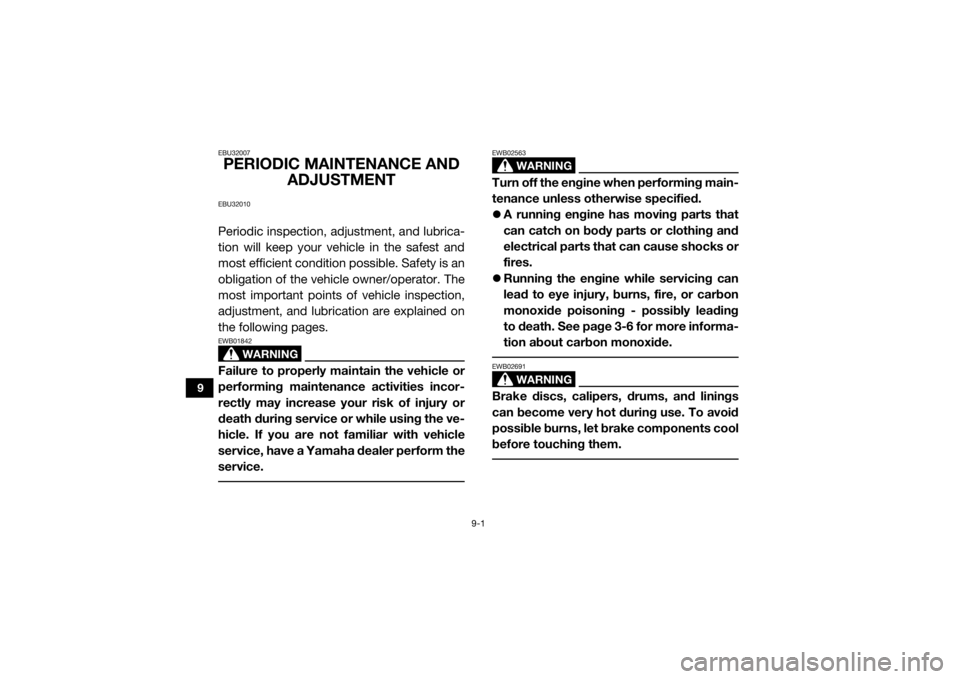warning YAMAHA YXZ1000R SS 2020 Owner's Guide
[x] Cancel search | Manufacturer: YAMAHA, Model Year: 2020, Model line: YXZ1000R SS, Model: YAMAHA YXZ1000R SS 2020Pages: 212, PDF Size: 9.36 MB
Page 91 of 212

6-9
6
Tire pressure
A tire pressure gauge is included as standard
equipment. Make two measurements of the
tire pressure and use the second reading.
Dust or dirt in the gauge could cause the first
reading to be incorrect.
Tire pressure must be checked and set when
the tires are cold. The tire pressure should be
the same on both sides, and must be adjust-
ed according to vehicle loading conditions.
Set the tire pressure as specified below.
WARNING! Operation of this vehicle with improper tire pressure may cause severe
injury or death from loss of control or roll-
over. Tire pressure below the minimum
specified could also cause the tire to dis-
lodge from the rim under severe driving
conditions.
[EWB04120]
1. Tire pressure gauge
1
UBAS7AE0.book Page 9 Wednesday, June 19, 2019 11:51 AM
Page 93 of 212

7-1
7
EBU31872
OPERATION
EBU31880Read the Owner’s Manual carefully to be-
come familiar with all controls. If there is a
control or function you do not understand,
ask your Yamaha dealer.
WARNING
EWB03290Failure to familiarize yourself with the con-
trols can lead to loss of control, which
could cause an accident or injury. EBU35720Engine break-inThere is never a more important period in the
life of your vehicle than the period between 0
and 20 hours.
For this reason, we ask that you read the fol-
lowing material carefully. Because the engine
is brand new, you must not put an excessive
load on it for the first several hours of opera-
tion. During the first 20 hours, the variousparts in the engine wear and polish them-
selves to achieve the correct operating clear-
ances.
During this period, prolonged full-throttle op-
eration or any condition that might result in
excessive engine heating must be avoided.
However, momentary (2–3 seconds maxi-
mum) full-throttle operation under load does
not harm the engine.
Each full-throttle acceleration sequence
should be followed with a substantial rest pe-
riod for the engine, by cruising at lower r/min
so the engine can rid itself of the temporary
build-up of heat. If any abnormality is noticed
during this period, consult a Yamaha dealer.
0–10 hours:
Avoid prolonged operation above 5300 r/min.
Allow a cooling-off period of 5 to 10 minutes
after every hour of operation. Vary the speed
of the vehicle from time to time. Do not oper-
ate it at one set throttle position.UBAS7AE0.book Page 1 Wednesday, June 19, 2019 11:51 AM
Page 94 of 212

7-2
7
10–20 hours:
Avoid prolonged operation above 6300 r/min.
After break-in:
The vehicle may now be operated normally.EBU36560Starting the engine1. Turn the key to “ ” (on).NOTICEECB03340The coolant temperature warning light,
YCC-S system warning light, and engine
trouble warning light should come on, then
go off.
The EPS warning light should come on,
then go off when the engine is started.
To avoid possible damage, do not operate
the vehicle if a warning light does not work
as described above. 2. Press the brake pedal.
3. Shift the transmission into neutral.
When the transmission is in the neutral
position, the transmission gear display
shows “N” and the neutral indicator
light should come on.
The engine can be started in any gear if
the brake pedal is applied. However, it
is recommended to shift into neutral
before starting the engine.
4. With your foot off the accelerator pedal, start the engine by turning the key to “ ”
(start).
If the engine fails to start, release the key, and
then try starting it again. Wait a few seconds
before the next attempt. Each attempt should
be as short as possible, to preserve battery
energy. NOTICE: Do not crank the engine
more than 5 seconds on each attempt, or
starter damage could occur. Wait at least
5 seconds between each operation of the
electric starter to let it cool.
[ECB02140]
Do not turn the key to the “ ” (start) position
with the engine running; otherwise, damage
to the electric starter may result.
UBAS7AE0.book Page 2 Wednesday, June 19, 2019 11:51 AM
Page 97 of 212

7-5
7
5. When vehicle speed has sufficiently in-creased, use the shift paddle “ ” to shift
into second gear (“2”).
6. Follow the same procedure when shifting to the next higher gear.
To decelerate
When slowing down, release the accelerator
pedal and apply the brake pedal smoothly. As
you slow down, shift to a lower gear. Be sure
that the engine has sufficiently slowed before
engaging a lower gear. Improper use of the
brake pedal or shift paddles can cause the
tires to lose traction, reducing control and in-
creasing the possibility of an accident.
WARNING
EWB00712Make sure the engine has sufficiently
slowed before shifting to a lower gear. En-
gaging a lower gear when the engine
speed is too high could make the wheels
stop rotating and lose traction. This could cause loss of control, an accident and inju-
ry. It could also cause engine or drivetrain
damage.
Recommended shift points
The recommended shift points during accel-
eration and deceleration are shown in the fol-
lowing table.TIPWhen coming to a stop under normal condi-
tions, AUTO DOWNSHIFT will shift the trans-
mission into first gear automatically. Shift up points:
1st → 2nd: 19 km/h (12 mi/h)
2nd → 3rd: 33 km/h (21 mi/h)
3rd → 4th: 44 km/h (27 mi/h)
4th → 5th: 53 km/h (33 mi/h)
Shift down points: 5th → 4th: 30 km/h (19 mi/h)
4th → 3rd: 17 km/h (11 mi/h)
UBAS7AE0.book Page 5 Wednesday, June 19, 2019 11:51 AM
Page 98 of 212

7-6
7
To drive in reverse
WARNING
EWB03300Before you shift into reverse, make sure
there are no obstacles or people behind
you. When it is safe to proceed, go slowly.
Hitting an obstacle or person could result
in serious injury or death. 1. Stop the vehicle and continue to apply the brake pedal.
2. Check behind you.
3. Shift the transmission into reverse.
TIP To shift into reverse, the engine must be
running and at idle speed.
When in reverse, the transmission gear dis-
play should show “R” and the reverse indi-
cator light should come on.
The reverse buzzer will sound while the
transmission is in reverse. 4. Release the parking brake (if applied).1. Drive select lever
2. Reverse gear
1
2
UBAS7AE0.book Page 6 Wednesday, June 19, 2019 11:51 AM
Page 100 of 212

7-8
7
the engine is not warmed up or is overheat-
ing.
the driver seat belt is not latched.
the differential gear is locked (“DIFF LOCK”
is selected) or the differential gear lock indi-
cator is flashing.
the parking brake is applied.
an engine or system malfunction is detect-
ed (a warning light is on). To activate the launch system1. Confirm that the front wheels and steer-
ing wheel are pointed straight ahead.
2. Shift the transmission into first gear.
3. While pressing the brake pedal, pull both
shift paddles toward you and hold them
in that position. The launch system indi-
cator light will come on, and the launch
system enters standby mode. 4. While checking in front of you for obsta-
cles or anything that may cross your
path, release the brake pedal, and then
press the accelerator pedal to rev the en-
gine to the desired launch engine speed.
TIPThe engine speed at launch must be be-
tween 5000–10000 r/min.
If you release one shift paddle, or if a sys-
tem restriction is detected during standby
mode, the launch system indicator light will
begin to flash and the launch will be can-
celled.
UBAS7AE0.book Page 8 Wednesday, June 19, 2019 11:51 AM
Page 104 of 212

7-12
7
EBU35441ParkingWhen parking, shift into first or reverse gear,
stop the engine, and then apply the parking
brake. See page 8-16 for when parking on a
slope.EBU35354LoadingTake extra precautions when driving with a
load. Turn gradually and drive more slowly
than you would without a load. The more
weight you carry, the slower you should go.
Although conditions vary, it is good practice
to keep the vehicle in a low gear when you are
carrying a heavy load. Follow these instruc-
tions and always use common sense and
good judgment when carrying a load.Cargo bed
Use the hooks equipped on the cargo bed
(page 5-31) to tie down loads. Make sure the
load is securely fast
ened down, centered in
the cargo bed, and not top-heavy. Never al-
low anyone to ride in the cargo bed.
WARNING
EWB03923Improper loading or any pulling or towing
will increase the risk of loss of control, an
overturn, or other accident:
Do not pull objects, other vehicles, or
tow a trailer—this vehicle is not de-
signed for such operation.
Keep weight in the cargo bed centered
side to side, and as low and as far for-
ward as possible. Top-heavy loads in-
crease the risk of overturn.
Make sure that cargo is securely fas-
tened down—a loose load could change
handling unexpectedly or strike occu-
pants.
UBAS7AE0.book Page 12 Wednesday, June 19, 2019 11:51 AM
Page 106 of 212

8-1
8
EBU31950
BASIC GUIDE FOR SAFE USE
EBU31962As a YXZ1000R owner you are responsible
for the safe and proper operation of this vehi-
cle. Read this chapter and review the safety
instructions in Chapter 3 before operating the
vehicle. Use these chapters and the labels on
the vehicle to instruct new operators and pas-
sengers. Do not allow anyone else to operate
the vehicle or ride as a passenger if you are
unsure that he/she is willing and able to follow
these instructions.
WARNING
EWB03340Follow these instructions to reduce your
risk of an accident and to reduce the risk
of serious injury or death in the event of an
accident.
EBU33513KNOW YOUR VEHICLEThis off-road vehicle will handle and maneu-
ver differently from cars, ATVs, go-carts, golf-
cars and grounds-keeping vehicles. The
YXZ1000R has higher ground clearance and
other features to handle rugged terrain, and,
as a result, can overturn in situations where
some vehicles may not. This would include
vehicles made primarily for pavement, roads,
improved paths, or grounds-keeping. If you
do not use care in maneuvering the
YXZ1000R, you can cause it to roll over even
on flat, open areas.
Doing things with a YXZ1000R that some
people do for thrills in other vehicles [such as
sideways sliding, skidding, fishtailing (rear-
wheel sliding), or donuts] have led to side roll-
overs. These rollovers can result in crushed
limbs and other serious injuries or death to
drivers or passengers.
UBAS7AE0.book Page 1 Wednesday, June 19, 2019 11:51 AM
Page 108 of 212

8-3
8
biles, to promote safe driving behaviors, you
should supervise younger drivers and consid-
er setting rules and putting limits on how,
when, and where the YXZ1000R can be used.
Passenger requirements
This vehicle is designed for the operator and
one passenger. Allowing passengers to ride
improperly can lead to serious injury or death.
As the operator, you are responsible for your
passenger.
Your passenger must be able to place both
feet on the floorboard while seated upright
with his/her back against the backrest.
Your passenger must be able to reach and
hold the passenger handhold.
Allow only one passenger in the vehicle and
only in the designated passenger seat. Do
not carry any other passengers. Do not car-
ry passengers in the cargo bed.
Do not allow someone to ride as a passen-
ger who has been using drugs or alcohol.
Do not allow children who need child safety
seats or booster seats in the YXZ1000R.
The seat belt is not designed to restrain au-
tomotive child safety seats.
Occupant protection system
WARNING
EWB03350Do not make changes to the occupant pro-
tection system. If you install aftermarket
products or have your vehicle modified,
you may put yourself and others at greater
risk of serious injury or death. You are re-
sponsible for any such changes to the ve-
hicle.
UBAS7AE0.book Page 3 Wednesday, June 19, 2019 11:51 AM
Page 128 of 212

9-1
9
EBU32007PERIODIC MAINTENANCE AND ADJUSTMENTEBU32010Periodic inspection, adjustment, and lubrica-
tion will keep your vehicle in the safest and
most efficient condition possible. Safety is an
obligation of the vehicle owner/operator. The
most important points of vehicle inspection,
adjustment, and lubrication are explained on
the following pages.
WARNING
EWB01842Failure to properly maintain the vehicle or
performing maintenance activities incor-
rectly may increase your risk of injury or
death during service or while using the ve-
hicle. If you are not familiar with vehicle
service, have a Yamaha dealer perform the
service.
WARNING
EWB02563Turn off the engine when performing main-
tenance unless otherwise specified.
A running engine has moving parts that
can catch on body parts or clothing and
electrical parts that can cause shocks or
fires.
Running the engine while servicing can
lead to eye injury, burns, fire, or carbon
monoxide poisoning - possibly leading
to death. See page 3-6 for more informa-
tion about carbon monoxide.
WARNING
EWB02691Brake discs, calipers, drums, and linings
can become very hot during use. To avoid
possible burns, let brake components cool
before touching them.
UBAS7AE0.book Page 1 Wednesday, June 19, 2019 11:51 AM